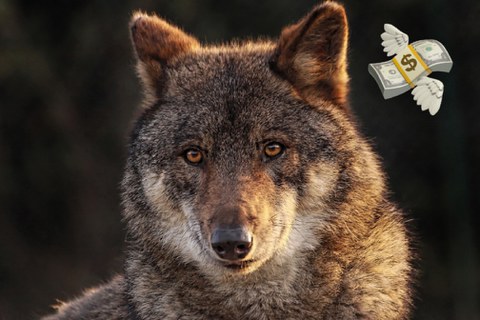May 05, 2024
Animals and Money: Potential economic impact of wolves Canis Lupus in Germany

100 years after going extinct wolves are back in German forests. This might have economical effects.
German fairytales are full of wolves, in contrast to German forests. Partly because of their bad image, wolves (Canis lupus lupus) were hunted to extinction and had been gone in Germany for more than 100 years. This was until the year2000 when wolves started to repopulate the country1. Ever since the wolf came back there has been a discussion about the economic impact of rising wolf populations.
Globally, Canis Lupus can be found all over the northern hemisphere. The population in Germany has grown constantly in the past years, counting 161 packs (=1175 individuals) in 2022 2, 3. The largest number of individuals in Germany is found in Brandenburg and Saxony2,4. Wolfs are predators and play an important role in the complex ecosystem of the forest. They naturally regulate the population size of their prey. By hunting for weak and sick individuals, predators in general play an important role in disease control of herbivore populations5, 6. Humans are not part of their prey and attacks are extremely rare7. However, wolves do not distinguish between wild animals and livestock which makes them a potential economic threat to farmers. Wolfs mainly hunt for forest animals like deer and boars, only 1% of their prey is livestock8. But wolf populations are growing and so is the number of attacks on livestock9. In 2021 roughly 3500 animals got harmed10. More than 85% of attacked livestock are sheep and goats10, 11,. Horses and cattle are rarely hunted because of their size and their ability to defend themselves12. Farmers can protect their livestock against the wolf with measurable effects. Electrified fences, livestock protection dogs, save shelters for the night and underground fences help to keep livestock safe13. Preventive measures are subsidised by the government with 16.639.800 € (in 2021). The government also compensates for some material damages caused by the wolf (498.433 €). Together those payments summed up to 17.138.233 € in 202114.
Now I want to estimate the financial damage the wolf causes by harming or killing sheep and goat. Prices per goat and sheep lie between 30 € and 150 € so I assume a price of roughly 100€15. A harmed animal costs roughly half the price of the animal. A total of 3500 livestock animals were harmed (85% sheep and goat) by wolves in 2021, but the data does not indicate how many of those animals survived or got killed. In the best case financially, all animals got harmed but survived (0,85*3500*100€*0,5), in the worst case all sheep and goat died during the attacks (0,85*3500*100€). This covers a range of financial damage between 148,750€ and 297,500€ in 2021. The value of the remaining 15,5% of attacked animals was not calculated here. Summed up with the damage compensation payments this sums up to costs of 17,286,983€ up to 17,435,733€ in 2021. To buffer the underestimation caused by unknown costs of damage due to car accidents and harmed cattle and horses, economic costs are rounded up to 18 million Euro per year. Costs due to livestock attacks can still be lowered by improving and increasing the use of preventive measures. Not only costs but also potential financial benefits can be discovered in the comeback of the wolf. Sightseeing of free-living wolves may be one potential attraction for tourists. Since the reintroduction of wolves in the Yellowstone national park, 44 % of the tourists visit the park especially to see wolves in their natural habitat and tourism in general increased by 5 %. This and changes in visitor spending increased the income of the park and associated shops by roughly 35,5 million USD16. Increased tourism is also visible in wild parks in Germany, but so far there is no survey on visitor behaviour change due to wolves17. Another positive side effect could be the behavioural change of wolves’ prey. Wolves use roads for traveling which could make deer avoid those roads. This may lead to reduced car accidents by an average of 24%18. In Germany, in 2020/2021 198.730 deers were killed in traffic accidents19. Per deer related accident, insurance companies paid 3200 € in 2021, which sums up to deer related financial damage of 660 million Euros20. If the reintroduction of wolves would really lead to 24% less car accidents, 158,4 million € could be saved. With the annual costs subtracted, wolves could have a financial benefit of 140,4 million €. On the other side the number of car accidents with wolves could potentially increase with a higher number of individuals (102 traffic accidents in 2022)2.
A first approach on calculating the financial impact of wolves suggests that the benefits of reintroduced wolves in Germany could outweigh the costs by factor 9. So far however, it is not possible to argue if wolves are indeed economically beneficial currently. At least with the wolf’s return humans get another chance of coexisting peacefully with a species they might be afraid of and maybe there will be a fairytale one day with the wolf as the good guy.
Aaron Clemens Mirko Anselmi
